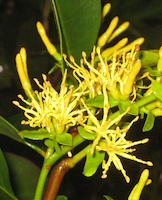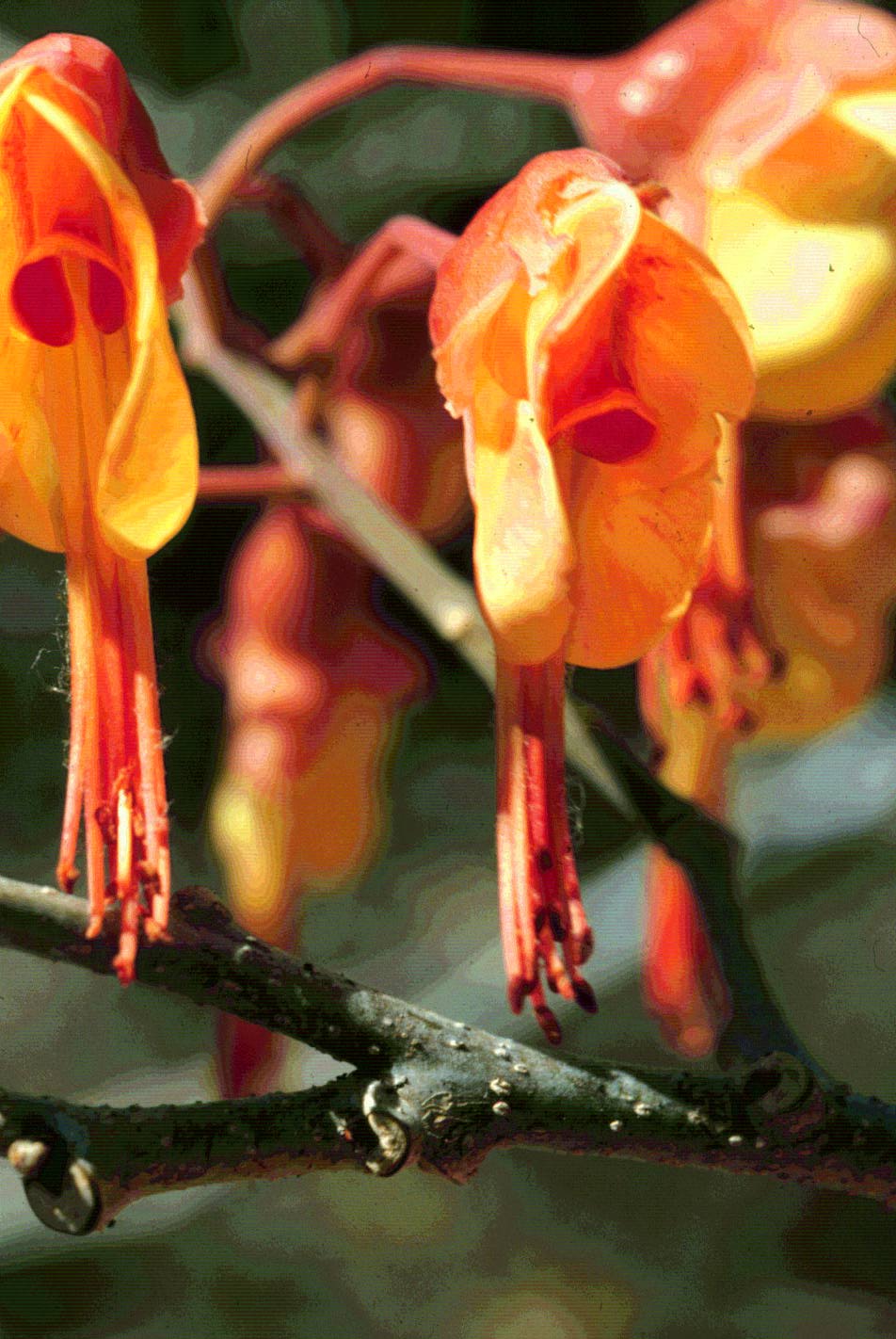 |
Readings for Tropical Plant Systematics, 2021 September 7, 2021 |
|
|
|
INTRODUCTORY
READING
Gentry,
A.W. 1988a Tree species richness in
upper Amazonian forests. Proc. Nat. Acad.
Sci. 85: 186-189.Gentry, A.W. 1988b. Changes in plant community diversity and floristic composition on environmental and geographical gradients. Annals Missouri Bot. Gard. 75: 1-34. (has the family lists) FAMILY READINGS
MAGNOLIIDS Myristicaceae LauraceaePiperaceaeTepe, E.J., M.A
Vincent, and L.E. Watson. 2007.
The importance of petiole structure on
inhabitability by ants in Piper sect. Macrostachys
(Piperaceae). Botanical Journal of the
Linnean Society 153: 181–191. MONOCOTS AraceaeChartier,
M., Gibernau, M. and Renner, S.S., 2014. The
evolution of pollinator–plant interaction types in
the Araceae. Evolution, 68(5), pp.1533-1543. Orchidaceae Cozzolino,
S. and Widmer, A., 2005. Orchid
diversity: an evolutionary consequence of
deception?. Trends in Ecology & Evolution,
20(9), pp.487-494. Adams, H. and Anderson, E., 1958. A conspectus of
hybridization in the Orchidaceae. Evolution,
pp.512-518. Xu, S., Schlüter, P.M., Scopece, G., Breitkopf, H.,
Gross, K., Cozzolino, S. and Schiestl, F.P., 2011.
Floral isolation is the main reproductive barrier
among closely related sexually deceptive orchids.
Evolution, 65(9), pp.2606-2620. Arecaceae Asmussen, C. B.,
Dransfield, J., Deickmann, V., Barfod, A. S.,
Pintaud, J. C., & Baker, W. J. (2006). A
new subfamily classification of the palm
family (Arecaceae): evidence from plastid DNA
phylogeny. Botanical Journal of the Linnean
Society, 151(1), 15-38. Eiserhardt, W. L., Svenning,
J., Kissling, W. D., & Balslev, H. (2011).
Geographical ecology of the palms (Arecaceae):
Determinants of diversity and distributions
across spatial scales. Annals of Botany,
108(8), 1391-1416. Nadot, S.,
Alapetite, E., Baker, W.J., Tregear, J.W.
and Barfod, A.S., 2016. The palm
family (Arecaceae): a microcosm of sexual
system evolution. Botanical Journal of the
Linnean Society, 182(2), pp.376-388. Trénel, P., Gustafsson,
M.H., Baker, W.J., Asmussen-Lange, C.B.,
Dransfield, J. and Borchsenius, F., 2007.
Mid-Tertiary dispersal, not Gondwanan
vicariance explains distribution patterns in
the wax palm subfamily (Ceroxyloideae:
Arecaceae). Molecular phylogenetics and
evolution, 45(1), pp.272-288. Bromeliaceae Reading Benzing, D.H., Givnish, T.J. and Bermudes, D., 1985. Absorptive trichomes in Brocchinia reducta (Bromeliaceae) and their evolutionary and systematic significance. Systematic Botany, pp.81-91. Other Literature Family Phylogeny: Givnish, T.J., Barfuss, M.H., Van Ee, B., Riina, R., Schulte, K., Horres, R., Gonsiska, P.A., Jabaily, R.S., Crayn, D.M., Smith, J.A.C. and Winter, K., 2011. Phylogeny, adaptive radiation, and historical biogeography in Bromeliaceae: insights from an eight-locus plastid phylogeny. American Journal of Botany, 98(5), pp.872-895.
Schulte, K., Barfuss, M.H. and
Zizka, G., 2009. Phylogeny of Bromelioideae
(Bromeliaceae) inferred from nuclear and plastid DNA
loci reveals the evolution of the tank habit within
the subfamily. Molecular Phylogenetics and
Evolution, 51(2), pp.327-339.
Benzing, D.H.,
Seemann, J. and Renfrow, A., 1978. The foliar
epidermis in Tillandsioideae (Bromeliaceae) and
its role in habitat selection. American Journal of
Botany, pp.359-365.
Givnish,
T., K.J. Sytsma, J.F. Smith, W.J. Hahn, D.H.
Benzing, and E.M. Burkhardt.
1997. Molecular evolution and adaptive
radiation in Brocchinia (Bromeliaceae:
Pitcairnioideae) atop tepuis of the Guayana
Shield. In: Givnish, T.J., Sytsma, K.J.
(Eds.), Molecular Evolution and Adaptive
Radiation. Cambridge University Press, New York,
pp. 259–311. CHECK OUT THE MAP OF THE
GUAYANA HIGHLANDS
EUDICOTS Rosids I (Fabids) Clusiaceae Reading Vlasáková,
B., Kalinová, B., Gustafsson, M.H. and Teichert,
H., 2008. Cockroaches as pollinators
of Clusia aff. sellowiana (Clusiaceae) on
inselbergs in French Guiana. Annals of botany,
102(3), pp.295-304. Other Literature Bittrich, V. and Amaral, M.C., 1996. Pollination
biology of Symphonia globulifera (Clusiaceae).
Plant Systematics and Evolution, 200(1-2),
pp.101-110. Farrell, B.D., Dussourd, D.E. and Mitter,
C., 1991. Escalation of plant defense: do latex and
resin canals spur plant diversification?. American
Naturalist, pp.881-900. Sweeney, P.W., 2008. Phylogeny and floral
diversity in the genus Garcinia (Clusiaceae) and
relatives. International Journal of Plant Sciences,
169(9), pp.1288-1303.
Malpighiaceae Reading Vogel, S.,
1990. History of the Malpighiaceae in the
light of pollination ecology. Memoirs of the New
York Botanical Garden, 55, pp.130-142. Other Literature Davis, C.C., Anderson, W.R. and Donoghue,
M.J., 2001. Phylogeny of Malpighiaceae: evidence
from chloroplast ndhF and trnL-F nucleotide
sequences. American Journal of Botany, 88(10),
pp.1830-1846. Vale, A., Navarro, L., Rojas, D. and Alvarez, J.C.,
2011. Breeding system and pollination by mimicry of
the orchid Tolumnia guibertiana in
Western Cuba. Plant species biology, 26(2),
pp.163-173. Euphorbiaceae Reading Armbruster,
W.S., 1994. Early Evolution of
Dalechampia (Euphorbiaceae): Insights from Phylogeny
Biogeography, and Comparative Ecology. Annals of the
Missouri Botanical Garden, pp.302–316. Other Literature Goel, G., Makkar, H.P., Francis, G. and
Becker, K., 2007. Phorbol esters: structure,
biological activity, and toxicity in animals.
International journal of toxicology, 26(4),
pp.279-288. Fabaceae Reading Kuprewicz,
E.K. and García-Robledo, C., 2010. Mammal
and insect predation of chemically and
structurally defended Mucuna holtonii
(Fabaceae) seeds in a Costa Rican rain forest.
Journal of Tropical Ecology, 26(03),
pp.263-269. Moraceae Reading Zerega,
N.J., Ragone, D. and Motley, T.J., 2004. Complex
origins of breadfruit (Artocarpus altilis,
Moraceae): implications for human migrations
in Oceania. American Journal of Botany, 91(5),
pp.760-766. Rosids II (Malvids) Melastomataceae Reading Other References Meliaceae MacKinnon,
S., Durst, T., Arnason, J.T., Angerhofer,
C., Pezzuto, J., Sánchez-Vindas, P.E.,
Poveda, L.J. and Gbeassor, M., 1997.
Antimalarial activity of tropical Meliaceae
extracts and gedunin derivatives. Journal of
Natural Products, 60(4), pp.336-341. Malvaceae Reading Judd,
W.S. and Manchester, S.R., 1997. Circumscription
of Malvaceae (Malvales) as determined by a
preliminary cladistic analysis of
morphological, anatomical, palynological,
and chemical characters. Brittonia, 49(3),
pp.384-405.
Atluri, J. B., Rao, S. P., & Reddi, C. S. (2000). Pollination ecology of Helicteres isora Linn.(Sterculiaceae). CURRENT SCIENCE-BANGALORE-, 78(6), 713-718. ASTERID WANNABES Loranthaceae Reading Pérez‐Crespo,
M.J., Ornelas, J.F., Martén‐Rodríguez,
S., González‐Rodríguez, A. and Lara, C.,
2016. Reproductive biology and
nectar production of the Mexican endemic
Psittacanthus auriculatus (Loranthaceae),
a hummingbird‐pollinated mistletoe. Plant
Biology, 18(1), pp.73-83. Cactaceae Reading Ogunbodede,
O., McCombs, D., Trout, K., Daley, P.
and Terry, M., 2010. New mescaline
concentrations from 14 taxa/cultivars of
Echinopsis spp.(Cactaceae)(“San Pedro”)
and their relevance to shamanic practice.
Journal of ethnopharmacology, 131(2),
pp.356-362.
Rubiaceae No Reading
ASTERIDS Rubiaceae Reading Ferrero,
V., Rojas, D., Vale, A. and Navarro, L.,
2012. Delving into the loss of
heterostyly in Rubiaceae: Is there a
similar trend in tropical and non-tropical
climate zones?. Perspectives in Plant
Ecology, Evolution and Systematics, 14(3),
pp.161-167.
Apocynaceae Reading Rodrigues,
I.D., Absy, M.L., da Silva-Caminha,
S.A.F., Esteves, V.G., Mendonça, C.B.F.,
Ferreira, M.G. and Moura, C.D.O., 2016.
Pollen morphology of 25 Apocynaceae
species in the Adolpho Ducke Forest
Reserve, Amazonas (Brazil). Palynology,
(just-accepted), pp.1-57. Bignoniaceae Castillo,
L. and Rossini, C., 2010. Bignoniaceae
metabolites as semiochemicals. Molecules,
15(10), pp.7090-7105. |
|
|
GENERAL
READINGS
(NOT ASSIGNED) Bernhardt, P. 2000. Convergent evolution and adaptive radiation of beetle-pollinated angiosperms. Plant Systematics and Evolution 222: 293-320. Furness, C.A. and P.J. Rudall. 2004. Pollen aperture evolution: a crucial factor for eudicot success? Trends in Plant Science 9: 154-158. Hickey, L.J., 1973. Classification of the architecture of dicotyledonous leaves. American journal of botany, pp.17-33. Hoorn, C. et al. 2010. Amazonia Through Time: Andean Uplift, Climate Change, Landscape Evolution, and Biodiversity. Science 330, 927-931. Litt, A., & Kramer, E. M. 2010. The ABC model and the diversification of floral organ identity. Seminars in cell & developmental biology 21: 129-137). McCall, A.C. and Irwin, R.E., 2006. Florivory: the intersection of pollination and herbivory. Ecology letters, 9(12), pp.1351-1365. Prychid, C. J. and P. J. Rudall. 1999. Calcium oxalate crystals in monocotyledons: a review of their structure and systematics. Annals of Botany 84: 725-739. Prychid, C.J., P..J. Rudall, and M. Gregory. 2004. Systematics and biology of silica bodies in monocotyledons. The Botanical Review 69: 377-440. Soltis, D.E,, C.D. Bell, S. Kim, and P.S. Soltis. 2008. Origin and early evolution of angiosperms. Annals of the New York Academy of Sciences 1133: 3-25. Werner, G.D., Cornwell, W.K., Sprent, J.I., Kattge, J. and Kiers, E.T., 2014. A single evolutionary innovation drives the deep evolution of symbiotic N2-fixation in angiosperms. Nature communications, 5. |
